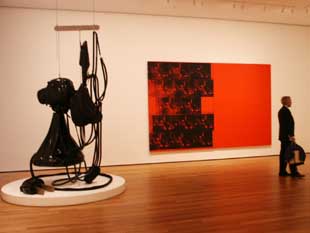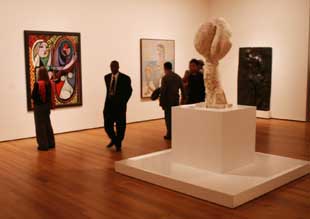
|
||
|
Portland art blog + news + exhibition reviews + galleries + contemporary northwest art
|
||
1st Anniversary Discussion of MoMA  It has been a year since The Museum of Modern Art reopened in Midtown Manhattan and in many ways MoMA has become the contemporary art equivalent of the elephant's graveyard. It is where we grieve and remember the death of giants and look at the bones while poachers scavenge for ivory tusks. It's a parade of masterpieces and names, an epistemology of aesthetics that (according to Saltz and others) the faithful recite like the Lord's Prayer or Pledge of Allegiance. Yet masterpieces like Picasso's Les Demoiselles d'Avignon, Barnett Newman's Vir Heroicus Sublimis and Matisse's The Red Studio are guaranteed to deliver the goods. MoMA has lost what I call its freak factor… lets just say MoMA is infuriating if you like to be infuriated by art occasionally. It just doesn't happen there… instead one gets the inevitable corporate Pixar retrospective on Dec 15th . I can't wait for the video art retrospective on the iPod…? At that point who needs MoMA's walls? The core of greatness in the early & mid twentieth century collections lets MoMA get lazy and its very telling that Robert Storr, the most intellectually engaged and talented (academic) curator of his time felt MoMA just wasn't home any more. I suspect he will return (the once and future curator) when he can be given the autonomy and integrity he deserves and demands. Storr has repeatedly challenged the party line of recent art history (market hype) by applying more ancient art history tropes as a litmus test. He even challenges his own experience as a practicing artist against the mandarin machinations of the art world in general. I'm interested if Storr can revive the 2007 Venice biennial? and I saw his 2004 Site Santa Fe biennial as a huge critique of MoMA and the general state of museum practices. It wasnt bombastic but it had focus and took risks. 
Still, the fact remains that the USA's cultural capital, New York, has lost its adolescent cultural verve and nowhere is it more apparent than MoMA, whose building seems to edit out mistakes. Instead of surprises we get the inevitable at MoMA and one wonders how much the decision to use Taniguchi as architect instead of Rem Koolhaas or Steven Holl suddenly framed the entire place as a mall/mausoleum? The new hang looks better for the contemporary galleries but it still seems completely devoid of balls. Simply put the space is too neutral and doesn't challenge the art objects enough or prompt the works to justify themselves (except maybe Newman's Broken Obelisk and the competition for viewing the immense crowds create). Where is the reevaluation? Although the collections aren't even laughably comparable, all I know is that the less than ultra ambitious or ideal new Jubitz Center for Modern and Contemporary Art in Portland feels more 21st century than MoMA does. It's funny because it's a pragmatic renovation of a 1920's Masonic temple! This is also true of the new corridors of the new Walker Arts Center and the Milwaukee Art Museum's Santiago Calatrava Wing. Tadao Ando's museum in Fort Worth manages to be both ideal and challenging in a way that MoMA utterly lacks. I love the decadence of devoting certain rooms to just one work of art and MoMA lacks this kind of extreme hedonism. Instead it seems encyclopedic. I also feel the art in MoMA has inherited Western Civilization's mid-life crisis with the progress of the industrial revolution; now even those stubbornly inefficient art markets have become ruthlessly efficient. Yet these fragmented and practically medieval markets (i.e. closed) remain largely unregulated (artist unions like the teamsters? It won't happen, yet…). This mating of feudal markets and industrial efficiency is compounding the art world's conservatism because the bigger collectors aren't invested with personal (and partly regional) pride like Saatchi had with the YBA's or Gertrude Stein had with Cubism. Hell even Alfred Barr Jr. had an infectious pride that Glenn Lowry lacks.  Nowhere was this lack of individual pride traded for a dollop of art by committee more apparent than the recent UBS corporate art show at MoMA. It was just too tidy, timid and "invested" to deserve a show at MoMA, I liked the version out here in Portland but MoMA can do better than that. Still MoMA might not be as dead as Jerry Saltz describes it and the museum recently took a cue from the Hammer Museum's successful resurrection of the tough to pigeonhole Lee Bontecou show. The Bontecou show eventually made its way to MoMA when it was in Queens during the rennovations. Bontecou is a worthy second tier but still major artist who disappeared and then reappeared because the Hammer wasn't afraid to step outside cannon. Now MoMA has resurrected yet another resurgent, major but second tier female artist Elizabeth Murray (notice how Robert Storr visits like George Clooney did on ER from time to time). Although I haven't seen the show in person the Murray show has deepened both my appreciation and bias against Murray as both too kitschy and not kitschy enough. What's more I've met her, she's bright but one feels as if she's unwilling to risk being pinned down. A leader accepts that mantel (often with a deft quirky move), and Murray, like Bontecou is possibly too selfish to achieve the generosity of artist like Agnes Martin or Gerhard Richter who are first tier. Lynda Benglis is also of that second tier rank (right now) but I suspect a retrospective of her would reveal her to be far more influential and generous than both Bontecou and Murray combined. Also, MoMA's choice of Murray seems less ballsey than Bontecou because Murray has been ever-present in the corporate art sphere, giving her an air of obnoxious boardroom inevitability and leads to viewer cynicism. Also, every time I see one of her works I want something meatier and feel like I've been cheated by a midway carnie. Artists like Richard Tuttle, Agnes Martin and the gorgeous Robert Smithson retrospective all delivered without the kind of beckoning calls that one gets from Murray's work. Maybe that is the problem with MoMA. It doesn't seem to risk its strengths like early and mid-century modernism or risk a strong reappraisal of the current moment through tough architecture. Instead, its spaces seem like cultured butlers tending to the art's every need. It's a softness that needs to go. Why not risk putting Robert Gober and Otto Dix together?… use MoMA like an art super collider not a hospice. Tyler Green begins his three part assesment of MoMA as well. Also, as mentioned before Jerry Saltz has made his one year assessment already. Posted by Jeff Jahn on November 20, 2005 at 22:36 | Comments (0) Comments Post a comment Thanks for signing in, . Now you can comment. (sign out)
(If you haven't left a comment here before, you may need to be approved by
the site owner before your comment will appear. Until then, it won't appear
on the entry. Thanks for waiting.)
|
| s p o n s o r s |
 |
 |
 |
 |
 |
 |
 |
 |
 |
 |
 |
 |
 |
 |

|
Site Design: Jennifer Armbrust | • | Site Development: Philippe Blanc & Katherine Bovee | |

